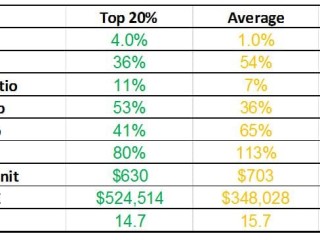Well before Indonesia reduced quotas and weight restrictions on exports last year, the northern beef industry was in financial difficulty.
The latest round of knee-jerk policy on the run, idiocy from Canberra has made the situation far worse. For people not affected by the live export debacle, the profitability of the industry is the worst it has been since the 1970’s beef slump. For people directly involved – it is worse.
The total below shows a breakdown of the financial indicators of the Queensland beef industry average over the last 3 years. In looking at these numbers, it must be kept in mind that the date is dominated by producers on better quality country in CQ.

The real data on the beef industry shows that cattle producers are not wealthy “kings in grass castles”. For seven of the last eight years, the average beef producer has spent more then they have earned. The top up has come from eating into equity or off farm jobs. The average beef producer has had a 1% Return on capital for the last five years and debt per animal unit has doubled. To put that into perspective, Woolworths has had an annual ROA of 12pc pa and has an asset turnover ratio of 320pc.
I was on the station in Northern Territory which started this era of exports during the 1970’s beef slump and have watched the industry invest heavily since then in what is the third era of the live export through Darwin in the last 120 years. This industry has grown for many fundamental reasons, which include:
- Complete lack of fattening country in the north, which means it is not suitable for an abattoir based industry.
- Near neighbours who want the type of stock the north can produce.
- Southern compatriots who do not want these cattle.
- The proximity of SE Asia, relative to markets east, south or west in Australia, which hare over 2000km away.
- Markets which do not want, and can not cope with boxed beef because of lack of refrigeration.
- The ability of importing countries to use waste products from other industries to feed cattle, such as PKE and pineapple waste. This can be achieved for a fraction of the cost of grain feeding in Australia.
Therefore any talk about northern cattle being slaughtered in Australia and then shipped to Indonesia is just as misguided as the ban. Discussion about putting Australians out of work in the meatworks in also rubbish, as few Australians now work in them and a large percentage of the labour is imported.
It is not just beef producers who have invested heavily on the basis of these market advantages. Business and Government have invested in trucks, holding yards, ports, shipping, stevedoring, helicopters, feedlots in Indonesia and the myriad of support industries such as vets, agents, nutritional suppliers, manufacturers, fuel distributors etc. etc.
The only way to improve the welfare of stock in Indonesia is to get the trade going again. Unfortunately this whole thing has been about a bigger agenda, not about the welfare of stock in Indonesia.
What kind of country have we become when with the whim of people with no knowledge and full bellies, we can destroy the livelihoods of Australians who were doing it tough already. How much more arrogant and disconnected can Australia be than where the welfare of some cattle in a foreign country is more important than feeding people in that country, recognizing they have customs too and looking after our own primary producers.
Terry McCosker, Resource Consulting Services
